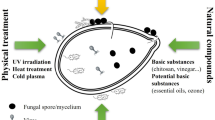Abstract
Sugarcane smut caused by Sporisorium scitamineum is one of the most devastating diseases of sugarcane. Two trialzole fungicides, propiconazole and triadimefon, have been used to protect seedcane from infection with sugarcane smut elsewhere, particularly after hot water treatment. These fungicides were registered under an emergency permit in Australia when smut was found for the first time in Queensland in 2006. A research program was initiated to screen and evaluate a range of fungicides against sugarcane smut. Nine fungicides were tested in vitro at various concentrations for their efficacy on smut spore germination. Azoxystrobin (Amistar®), quintozene (Quintozene® 750) and didecyl dimethyl ammonium chloride (Steri-max®) completely stopped germination of teliospores at 2.5 mg a.i./L. Propiconazole (Tilt®), triadimefon (Bayleton®), cyproconazole (Alto®) and acibenzolar-s-methyl (Bion®) significantly (P < 0.05) reduced spore germination at 50, 100 and 200 mg a.i./L. Two field trials were planted in spring 2008 and autumn 2009, where cane setts that had been inoculated with smut were dipped in a range of fungicide suspensions for five or 10 min, prior to planting. Cyproconazole, propiconazole, triadimefon and azoxystrobin significantly (P < 0.05) suppressed disease expression for up to 6 months in a summer experiment and 9 months in an autumn experiment. These results have important implication for selecting new fungicides for the control of sugarcane smut in seedcane that is provided to Australian sugarcane growers as a disease-free propagation source.

Similar content being viewed by others
References
Anon (1983) Report of the Hawaiian Sugar Partner’s Association Experiment Station 1982, pp 65
Bailey RA (1979) Possibilities for the control of sugarcane smut (Ustilago scitaminea) with fungicides. Proc S Afr Sugar Technol Assoc 53:137–142
Bailey R (1980) Possibilities for the control of sugarcane smut (Ustilago scitaminea) with fungicides. South African Sugar J 1980:158–164
Bailey RA (1983) The effect of soil and seedcane applications of triadimefon on the incidence of sugarcane smut (Ustilago scitaminea). Proc. South African Sugar Technol Assoc (June): 99–104
Bharathi V (2009) Chemical control of sugarcane smut through sett treatment with fungicides. Int J Plant Prot 2:151–153
Bhuiyan SA, Croft BJ, Cox MC, Bade G (2010) Varietal resistance of sugarcane to natural infection of smut–preliminary results. Proc Aust Soc Sugar Technol 32:355–365
Bock KR (1964) Studies on sugarcane smut (Ustilago scitaminea) in Keny. Trans Br Mycol Soc 47:403–407
Comstock JC (2000) Smut. In: Rott P, Bailey RA, Comstock JC, Croft BJ, Saumtally AS (eds) A guide to sugarcane diseases. CIRAD and ISSCT, Montpellier, pp 181–185
Comstock JC, Ferreira SA, Tew TL (1983) Hawaii’s approach to control of sugarcane smut. Plant Dis 67:452–457
Croft BJ, Braithwaite KS (2006) Management of an incursion of sugarcane smut in Australia. Australas Plant Pathol 35:113–122
Croft BJ, Cox MC (2007) Procedures for the establishment and operation of approved-seed plot. Manual MN07002 (Third edition). BSES Limited, Queensland, p 33
Croft BJ, Magarey RC, Allsopp PG, Cox MC, Willcox TG, Milford BJ, Wallis ES (2008a) Sugarcane smut in Queensland: arrival and emergency response. Australas Plant Pathol 37:26–34
Croft BJ, Berding N, Cox MC, Bhuiyan S (2008b) Breeding smut-resistant sugarcane varieties in Australia: progress and future directions. Proc Aust Soc Sugar Technol 30:125–134
Ferreira SA, Comstock JC (1989) Smut. In: Ricaud C, Egan BT, Gillaspie AG Jr, Hughes CG (eds) Diseases of sugarcane. Elsevier, Amsterdam, pp 211–229
Girard JC, Rott P (2000) Pineapple disease. In: Rott P, Bailey RA, Comstock JC, Croft BJ, Saumtally AS (eds) A guide to sugarcane diseases. CIRAD and ISSCT, Montpellier, pp 131–135
Hoy JW (1993) Sugarcane smut in Louisiana: biology and control. Bulletin Louisiana Agril Exp Stn, pp. 31. USA
Hoy J (2000) Pythium root rot. In: Rott P, Bailey RA, Comstock JC, Croft BJ, Saumtally AS (eds) A guide to sugarcane diseases. CIRAD and ISSCT, Montpellier Cedex, pp 141–146
Hoy JW, Hollier CA (2009) Effects of brown rust on yield of sugarcane in Louisiana. Plant Dis 93:1171–1174
Hoy JW, Hollier CA, Fontenot DB, Grelen LB (1986) Incidence of sugarcane smut in at ground level, topped above the last Louisiana and its effect on yield. Plant Dis 70:59–60
James AP, Braithwaite KS, Magarey RC, Croft BJ (2007) Laboratory support systems for the sugarcane smut effort. Proc Aust Soc Sugar Technol 29:176–182
Lee-Lovick G (1978) Smut of sugarcane–Ustilago scitaminea. Rev Plant Pathol 57:181–188
Magarey RC, Bull JI, Sheahan T, Denney D (2010) Yield losses caused by sugarcane smut in several crops in Queensland. Proc Aust Soc Sugar Technol 32:347–354
McFarlane K, Moodley D, Chinnasamy G, McFarlane SA (2007) Laboratory, glasshouse and field assessments of fungicides to control Ustilago scitaminea, casual organism of sugarcane smut. Proc Intl Soc Sugar Technol 25:1031–1035
Natarajan S, Muthusamy S (1981) Control of sugarcane smut with fungicides. Sugar Pathol Newsletr 26:40–43
Shaner G, Finney RE (1977) The effect of nitrogen fertilization on the expression of slow-mildewing resistance in Knox wheat. Phytopathology 67:1051–1056
Stoll M, Piepenbring M, Begerow D, Oberwinkler F (2003) Molecular phylogeny of Ustilago and Sporisorium species (Basidiomycota, Ustilaginales) based on internal transcribed spacer (ITS) sequences. Can J Bot 81:976–984
Wright PJ, Fullerton RA, Koolaard JP (2006) Fungicide control of head smut (Sporisorium reilianum) of sweet corn (Zea mays). N Z J Crop Hortic Sci 34:23–26
Acknowledgment
Syngenta Australia provided some of the fungicides.
Author information
Authors and Affiliations
Corresponding author
Rights and permissions
About this article
Cite this article
Bhuiyan, S.A., Croft, B.J., James, R.S. et al. Laboratory and field evaluation of fungicides for the management of sugarcane smut caused by Sporisorium scitamineum in seedcane. Australasian Plant Pathol. 41, 591–599 (2012). https://doi.org/10.1007/s13313-012-0139-1
Received:
Accepted:
Published:
Issue Date:
DOI: https://doi.org/10.1007/s13313-012-0139-1




